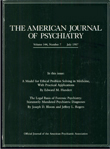Treatment of Anorexia Nervosa With Tramadol
To the Editor: Reports of pharmacological treatments of anorexia nervosa have been mixed. Selective serotonin reuptake inhibitors (SSRIs), the treatment of choice, may be helpful after restoration of weight in some patients. However, in underweight patients, SSRIs are generally not helpful and, in some cases, may contribute to further weight loss (1). Endorphins have been implicated in the pathology of eating disorders (2). Moreover, naltrexone has been reported to be useful in the treatment of anorexia nervosa (3). The following is a report of the successful use of tramadol, aselective mu opiate agonist with significant monoamine-reuptake-inhibiting effects (4), in the treatment of anorexia nervosa.
Ms. A was a 19-year-old woman who met DSM-IV criteria for anorexia nervosa, restricting type. At age 15 she had weighed 122 lb and had experienced normal menses. At 16 she had begun to exhibit ritualistic eating behavior. She ate little or nothing during the day. Every night she prepared a specific brand of low-calorie frozen dinner for her evening meal. She ate her meal in her room at precisely 6:00 p.m. and followed each meal with a snack exactly 2 hours later. By age 17 she weighed 101 lb and was amenorrheic.
Initially, she had expressed fear of weight gain. After 2 years of psychotherapy, she appeared to have attained an understanding that she was seriously underweight and her eating rituals were unreasonable. Whether this was true insight is uncertain. She felt ashamed and frustrated but reported no depressed mood, difficulties with sleep, fatigue, or inability to concentrate. Although her symptoms contained an element of obsessive-compulsive disorder, they were entirely linked to food. She did not engage in cleaning or checking behaviors and reported no compulsive slowness or fear of contamination. Roughly 18 months before I saw her, she had started taking fluoxetine. Her dose had been titrated to 60 mg/day. She had remained at that dose for nearly 6 months, but her condition had not improved.
Treatment with tramadol, 50 mg t.i.d., was initiated. Within the first week, Ms. A was more relaxed about food and was able to eat dinner at a restaurant and at a sorority function. Although she mostly kept to her eating schedule, she reported, “I might not have to.” Her tramadol dose was increased to 75 mg t.i.d., and in the subsequent 2 weeks she grew less constrained by her eating schedule and increased her food intake in the morning and afternoon. After 7 weeks of tramadol therapy, she reported she was “doing great.” She no longer scheduled her eating, she felt free to eat wherever and whatever she chose, and she gained 13 lb. She experienced no adverse effects.
The patient’s improvement may have been due to a new therapeutic alliance, to a strong expectancy created by or conveyed to the patient, or simply to coincidence. Although the present report suggests that opioid agonists or partial agonists may be useful in the treatment of anorexia nervosa, a placebo-controlled clinical trial is necessary to confirm the efficacy of tramadol.
1. American Psychiatric Association: Practice guideline for the treatment of patients with eating disorders (revision). Am J Psychiatry 2000; 157(Jan suppl):1–39Google Scholar
2. Yim GK, Lowy MT: Opioids, feeding, and anorexias. Fed Proc 1984; 43:2893–2897Google Scholar
3. Marrazzi MA, Bacon JP, Kinzie J, Luby ED: Naltrexone use in the treatment of anorexia nervosa and bulimia nervosa. Int Clin Psychopharmacol 1995; 10:163–172Crossref, Medline, Google Scholar
4. Raffa RB, Friderichs E, Reiman W, Shank RP, Codd EE, Vaught JL: Opioid and nonopioid components independently contribute to the mechanism of action of tramadol, an “atypical” opioid analgesic. J Pharmacol Exp Ther 1992; 260:275–285Medline, Google Scholar



